Selecting the Perfect Bathroom Cabinet
- modersyinterior
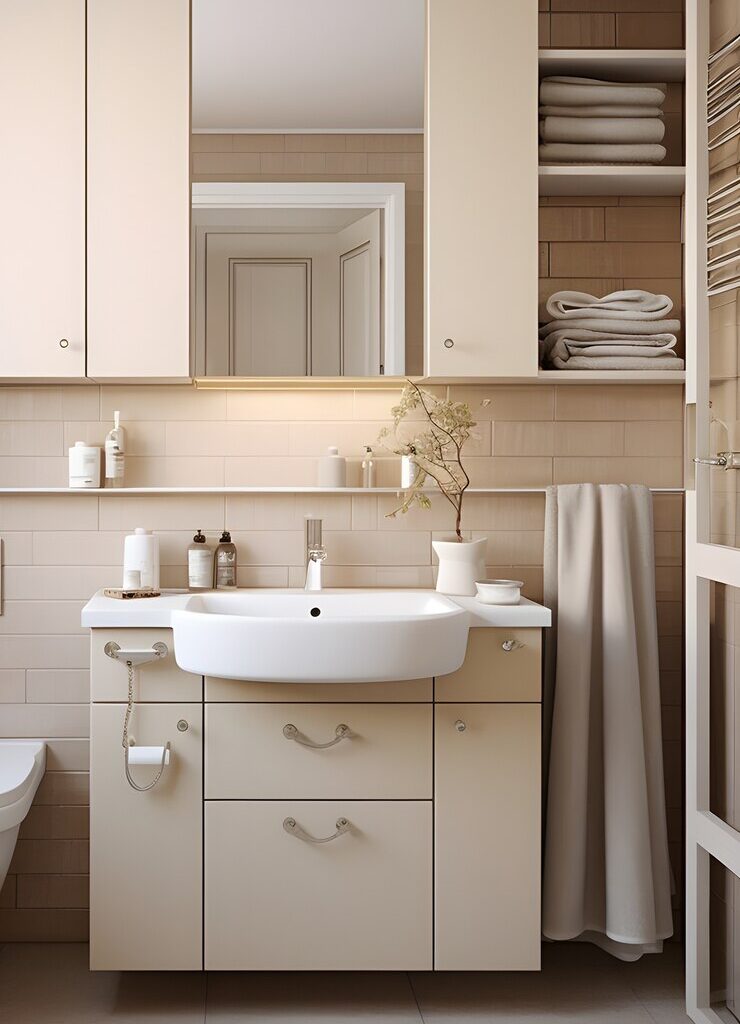
Nowadays, a bathroom is only complete with functional furniture that facilitates organized storage. An indispensable element in this setting is a cabinet, a crucial component in virtually every bathroom design. It serves as a storage space for hygiene essentials and various household gadgets.
With many options available, manufacturers provide cabinets catering to all preferences, featuring various colors, materials, styles, and sizes suitable for compact and spacious bathrooms.
How, amidst this array of choices, to make the challenging choice of opting for the ideal cabinet that contributes to creating an efficient and cozy space?
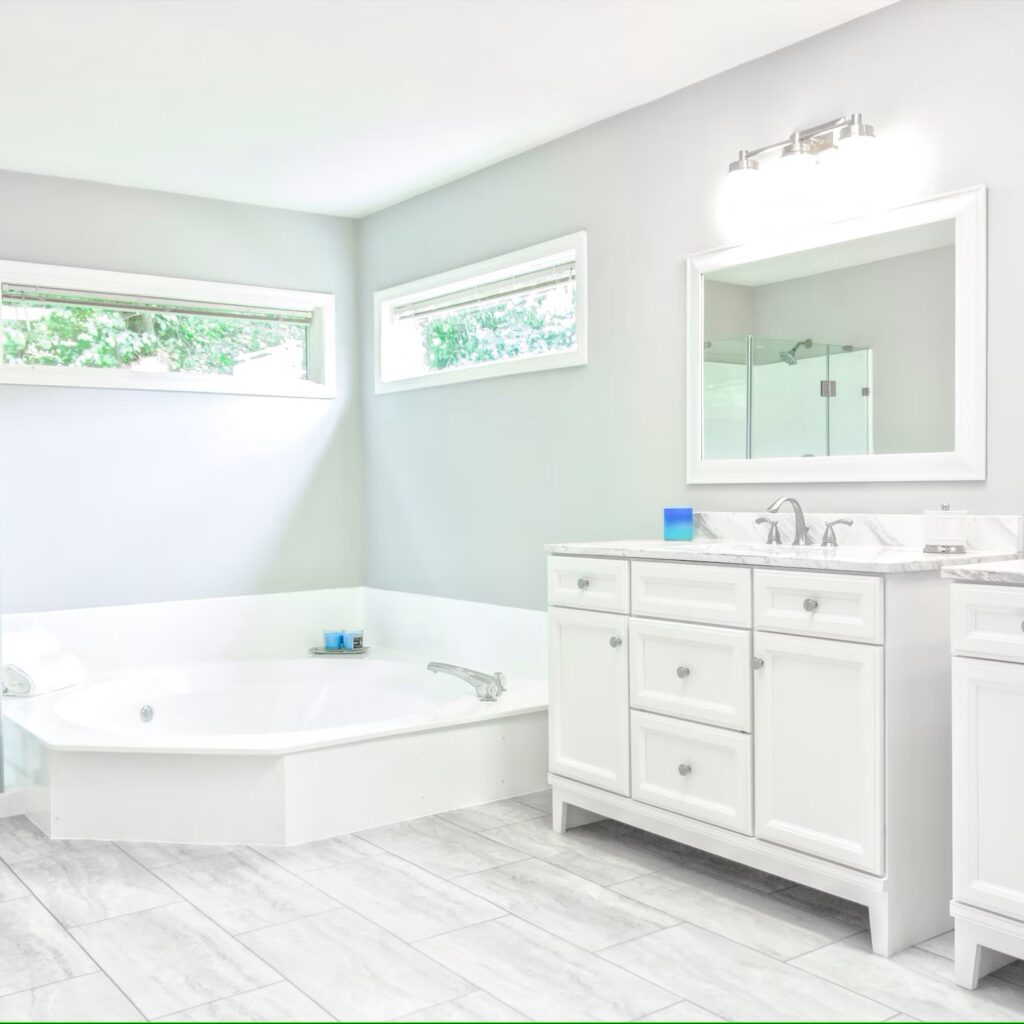
Advantages of Cabinets for the Bathroom
In any constructive version, bathroom cabinets have several advantages:
- provide an ergonomic solution for organizing storage in the bathroom
- serve as a dressing table
- hide unsightly communications
- make the bathroom interior more saturated
- soften the overall perception of space.
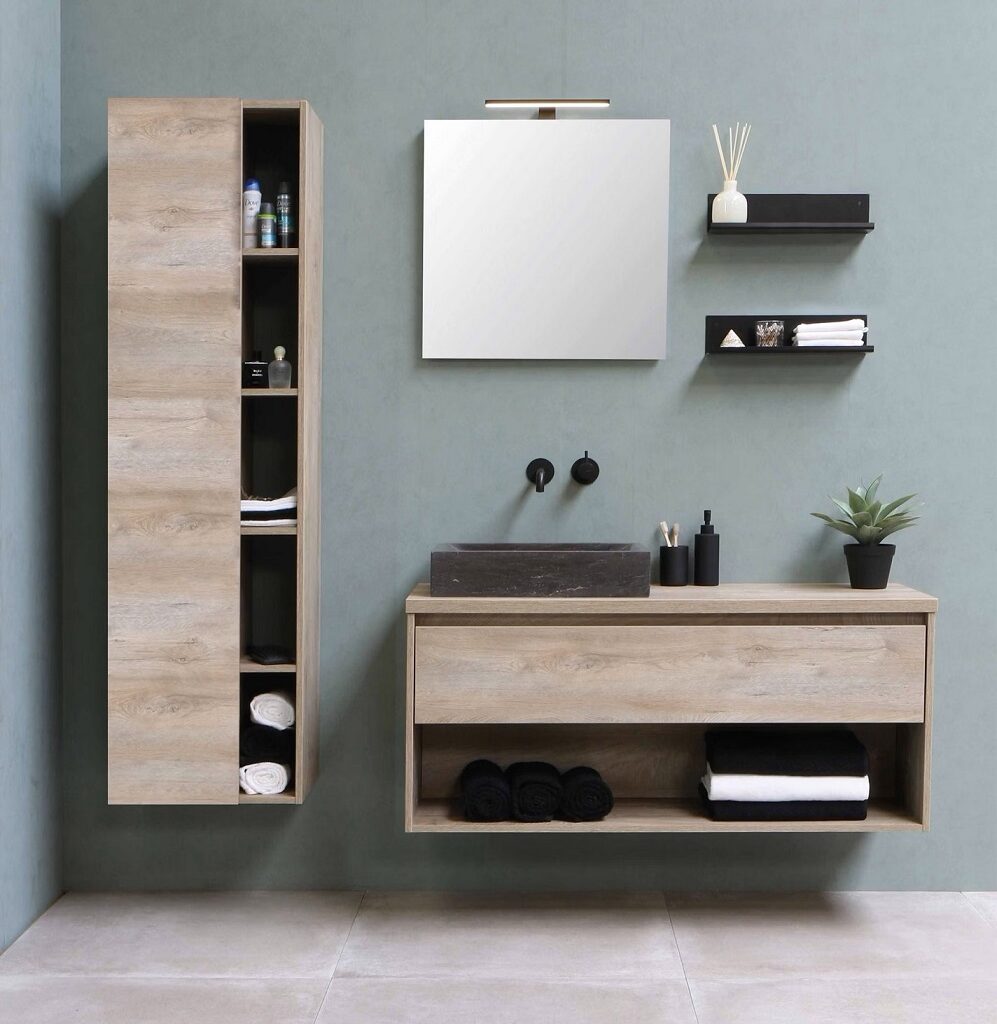
Selecting the Right Cabinet Shape for Your Bathroom
Consider the specific layout of your bathroom when choosing the cabinet’s shape:
- Straight: This classic style is the most common and versatile option.
- Corner: It is ideal for utilizing bathroom corners and maximizing space efficiency.
- Horizontal: This is a low, wall-length cabinet offering expansive surface area.
The size of your bathroom influences the cabinet installation approach:
- Floor models: These are sturdy and spacious, without needing extra support. They’re well-suited for bathrooms of any size.
- Hinged models: These cabinets are space-efficient, freeing up floor space for other appliances and furniture, making them perfect for smaller bathrooms; but their installation is more complex.
Types of Bathroom Cabinets
1. Wall-Mounted Cabinets
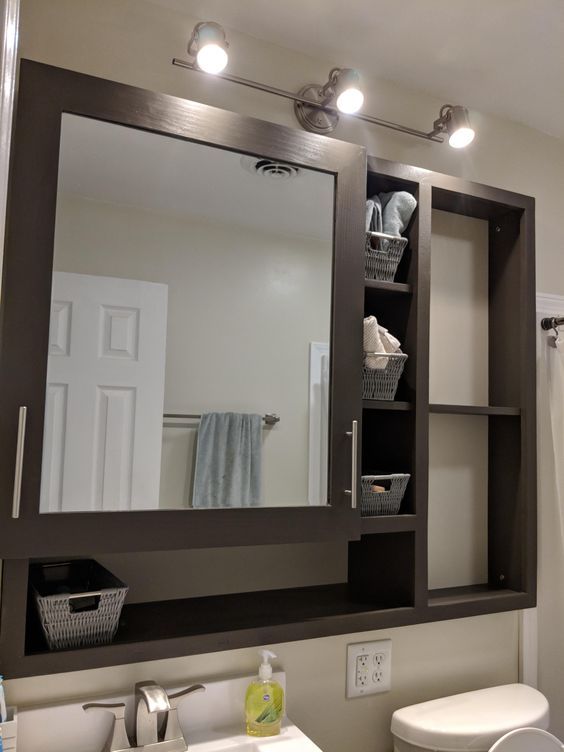
Wall-mounted cabinets are lifesavers for compact bathrooms. They create room for appliances like washing machines while visually unloading the space. They create room for appliances like washing machines while visually unloading the space.
These cabinets are typically installed above sinks, washing machines, or mid-wall. Corner variants are also available, offering additional space efficiency.
The main advantage of wall-mounted cabinets is the ease of accessing stored items. However, they may present challenges such as complex installation, limited storage capacity, and a remote risk of detachment (which would require significant force, like hanging from the cabinet).
It’s recommended to position these cabinets over the sink, particularly if they have mirrored doors, aligning the cabinet’s width with that of the washbasin for a cohesive look.
2. Floor Cabinets
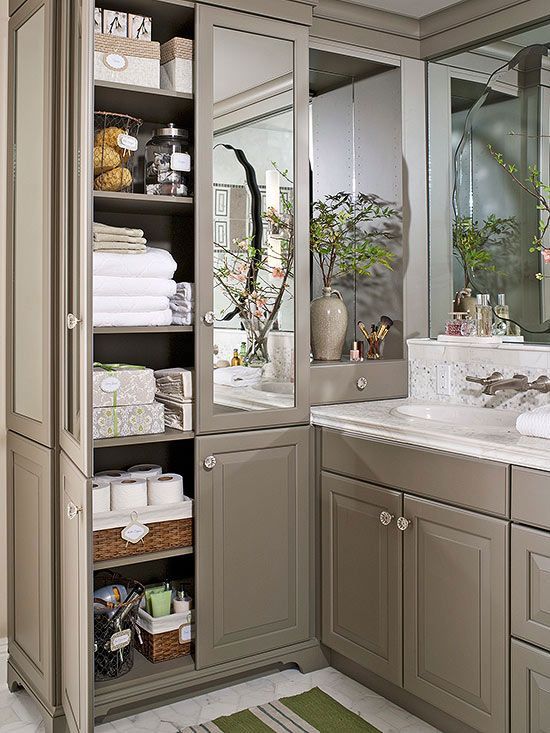
Floor cabinets are a staple in bathroom furnishings. They serve as storage for personal and hygiene products and clever concealment for appliances like washing machines and plumbing fixtures. Their design often includes a variety of drawers, baskets, shelves, and hooks for organizing various items.
For those favoring wooden furniture, legged models are a wise choice. This design elevates the cabinet, safeguarding it against potential water damage. Additionally, this setup facilitates easy cleaning in hard-to-reach areas.
A significant benefit of floor cabinets is the elimination of wall drilling or mounting systems for installation. They offer the flexibility of being easily relocated or repurposed within the bathroom, allowing for effortless refreshment of the room’s layout.
3. Pencil Case Cabinets
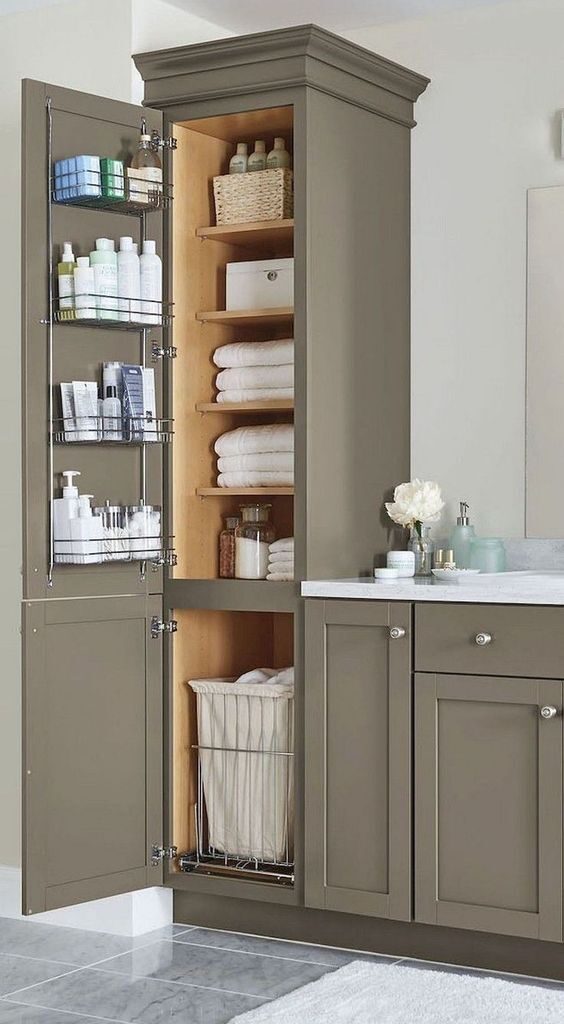
They are ideal for smaller bathrooms; tall slim cabinets are space-efficient, offering ample storage while occupying minimal floor area. These units use vertical space, extending up towards the ceiling.
With their array of shelves, drawers, and baskets, they provide a neat solution for organizing and storing various items. It’s advisable to place heavier items like household cleaning agents on the lower shelves to enhance the cabinet’s stability. At the same time, personal hygiene products can be conveniently stored on the upper shelves.
These slender cabinets can fit snugly in any bathroom corner or flank the sink to create a balanced look. Available in both floor-standing and wall-mounted varieties, this style suits every preference.
Despite their compact footprint, these cabinets can hold many bathroom essentials.
4. Wardrobe-Coupe Cabinets
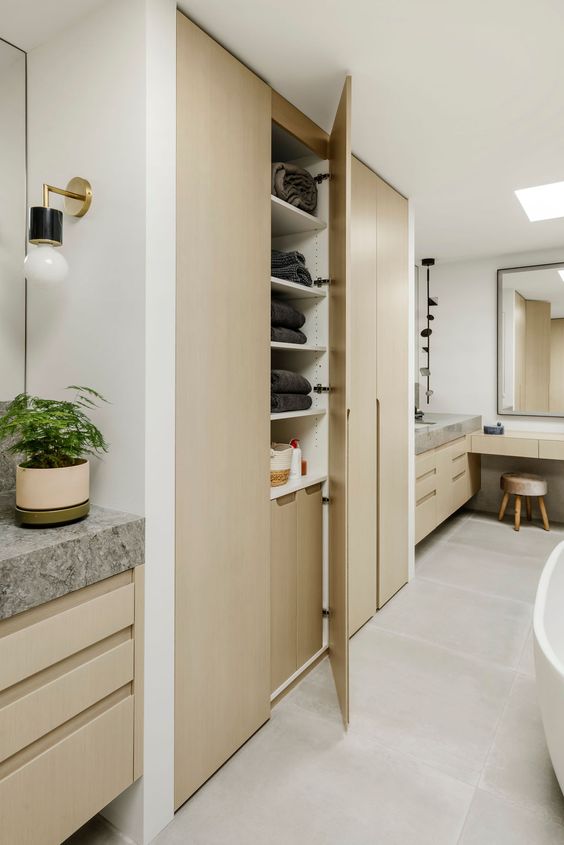
Wardrobe-coupe cabinets, commonly seen in bedrooms and hallways, are an unconventional yet spacious bathroom storage solution. This type of cabinet is especially fitting for larger bathrooms, as it occupies more space but offers extensive storage capacity. It can conceal everything from personal items to household appliances, effectively decluttering the room.
These cabinets have three main placement options:
- within a niche
- near a free wall
- in the middle of the room.
The last option allows to zone the room perfectly, thus being particularly useful in combined bathroom spaces.
5. Mirror Cabinets
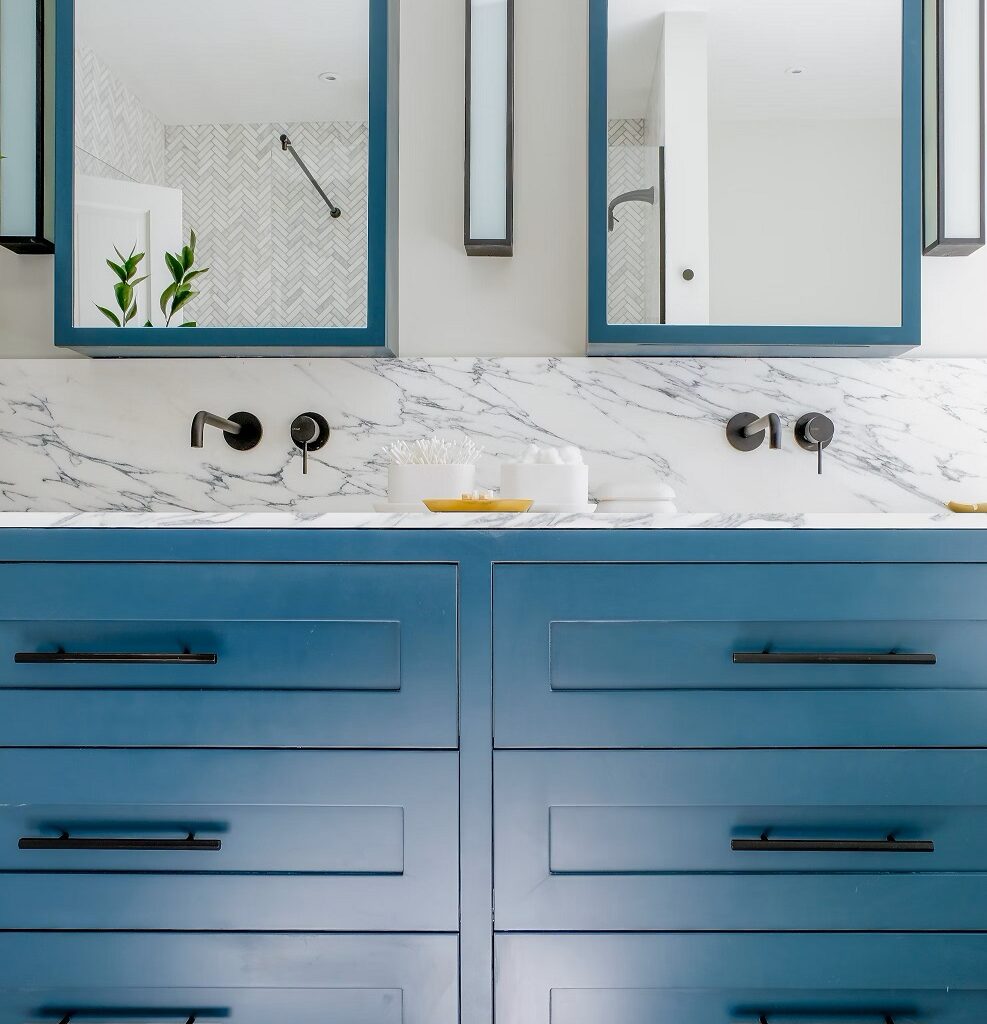
A mirror is indispensable in any bathroom and essential for daily grooming routines.
While a stand-alone mirror is an option, a more space-efficient solution is a mirror-integrated cabinet. This not only saves physical space but also is cost-effective. Additionally, the mirror’s reflective surface can visually expand the bathroom, making it appear more spacious.
Various styles are available:
- cabinets with doors fully covered by a mirror
- cabinets where only a portion of the door features a reflective surface
- cabinets with additional shelving around the sides, top, and bottom of the mirror
- cabinets with integrated lighting, such as spotlights or LED strips
- cabinets with high-tech and intelligent features, like built-in clocks, anti-fog systems, or integrated monitors.
With such a diverse range of choices, a mirror cabinet suits every bathroom’s needs and style.
6. Corner Cabinets
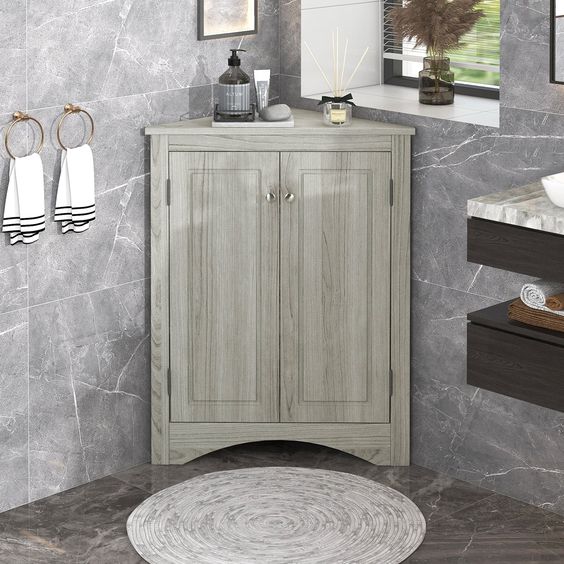
Corner cabinets are versatile and come in all the previously mentioned styles:
- floor cabinets
- wall-mounted cabinets
- mirror cabinets
- pencil case cabinets
- wardrobe-coupe cabinets.
These cabinets are known for their compact design yet surprising spaciousness, making them an ideal choice for smaller spaces. In terms of placement, they are highly convenient, fitting seamlessly into any available corner of the room without issue.
Material Considerations for Crafting Cabinets in Bathrooms
Choosing a suitable material for bathroom furniture is crucial due to the need for high moisture resistance and tolerance to frequent temperature changes. This makes the selection process for bathroom cabinet materials quite significant, with manufacturers offering a range of options that vary in cost, appearance, and durability.
Solid Wood
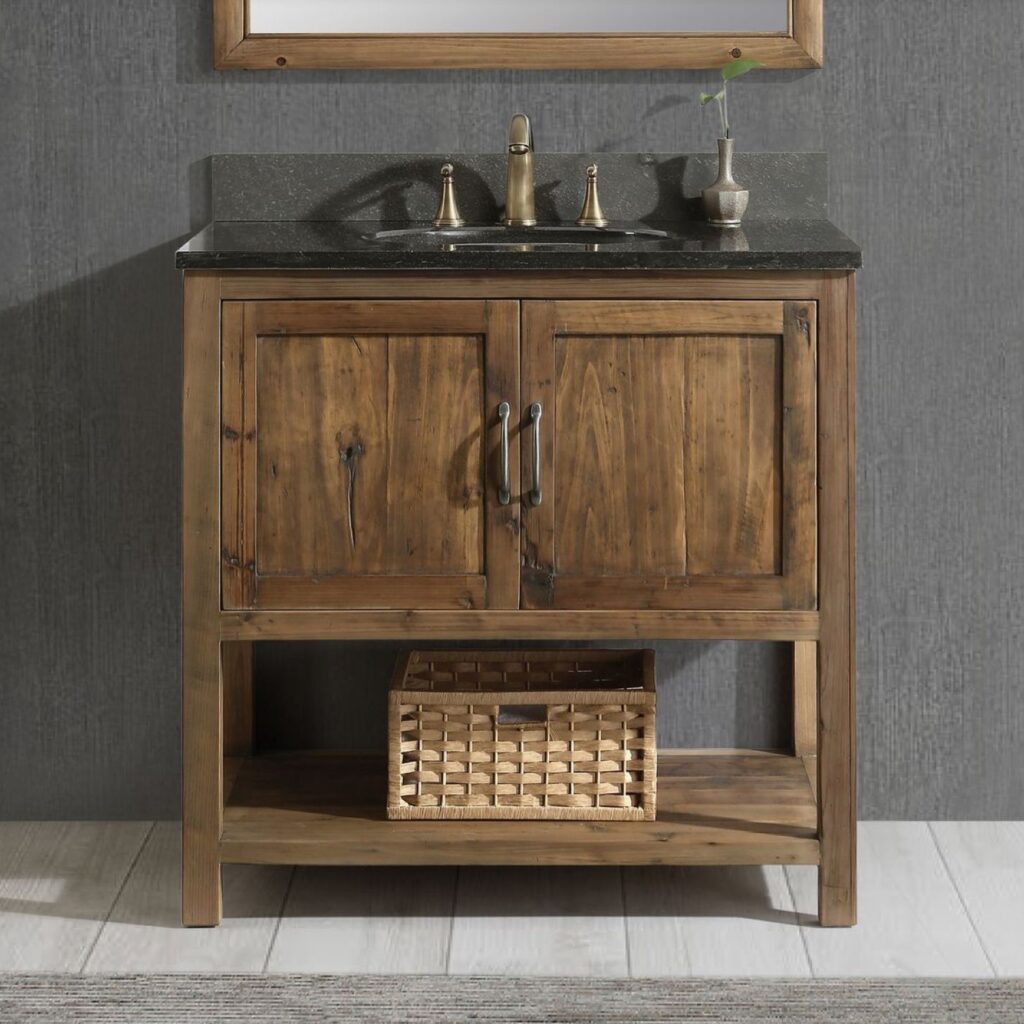
For a touch of luxury and style in bathroom furnishings, solid wood stands as a premium choice. These cabinets look opulent and sophisticated, adding a unique flair to the interior décor. Various designs are available, catering to individual tastes and preferences.
However, practical aspects reveal some drawbacks. Even though wood undergoes treatment to enhance its water resistance, prolonged exposure to humid conditions can still impact the furniture’s look. Regular maintenance with specific protective solutions is necessary to preserve its aesthetic appeal.
Plastic
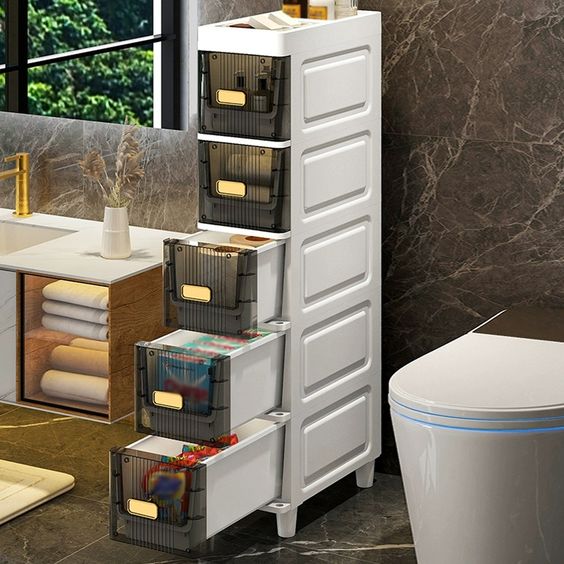
Plastic offers a vast palette of colors, making it easy to find a cabinet that suits any bathroom decor. As a material for bathroom furniture, it’s practical, durable, and boasts all the essential qualities needed for long-term use. This low-maintenance option doesn’t demand extensive care and is relatively user-friendly. Additionally, its affordability makes plastic an even more appealing choice. However, plastic is somewhat pliable. With regular use, there’s a possibility of parts becoming slightly deformed.
Laminated Particle Board
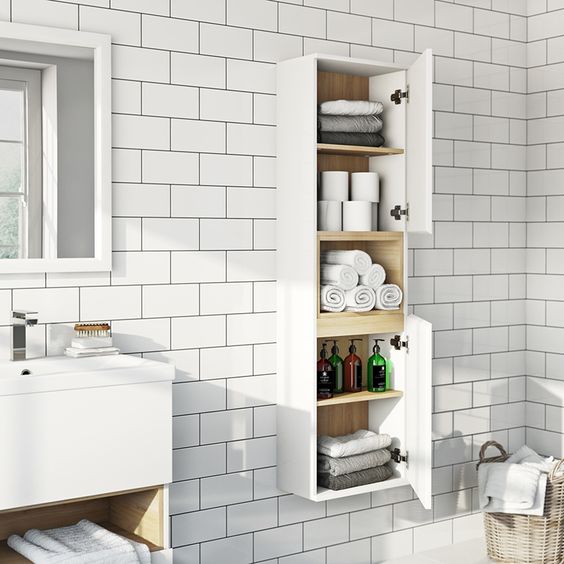
Furniture made from particle board coated with a laminated layer is a superb bathroom choice. This material offers notable moisture resistance and a wide array of color options and is reasonably priced, making it a strong contender in the bathroom furniture market.
When using laminated particle boards, it’s essential to consider the installation method. Cabinets with a plinth base may eventually experience swelling due to moisture absorption. Opting for models with legs can be a better choice to mitigate this issue.
MDF
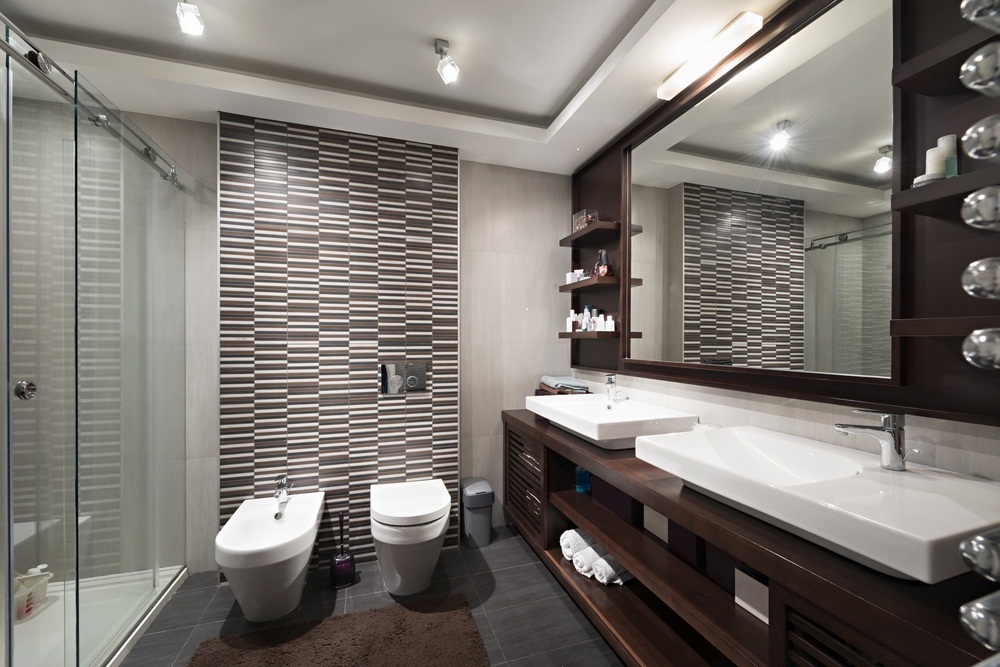
MDF’s malleable nature allows the creation of unique furniture designs, such as cabinets with curved or convex fronts, which can be particularly fitting for bathroom interiors. While MDF is pricier than particle board, its longevity justifies the cost. The material boasts a diverse color range, including options that mimic the look of wood, natural stone, brick, and pebbles, offering a wealth of possibilities for interior design.
Metal and Glass

Finding bathroom furniture made entirely of metal or glass is rare, but incorporating these materials can significantly impact the room’s aesthetics. Glass components, such as doors or shelves, add a light, airy feel to the space. In contrast, metal elements introduce a sleek shine, drawing attention to specific details.
Stone
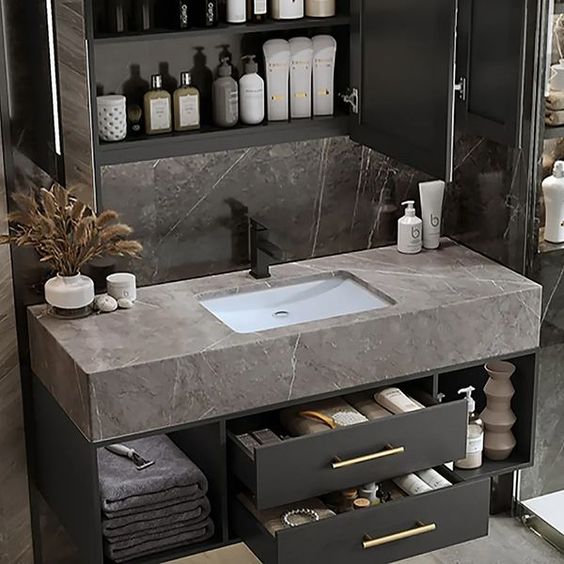
Natural or artificial stone is predominantly used for countertops in classic bathroom floor cabinet designs. Furniture made entirely of stone can be overly heavy, potentially overwhelming the space and turning the material’s benefits into drawbacks.
Bathroom Cabinet Color Choices
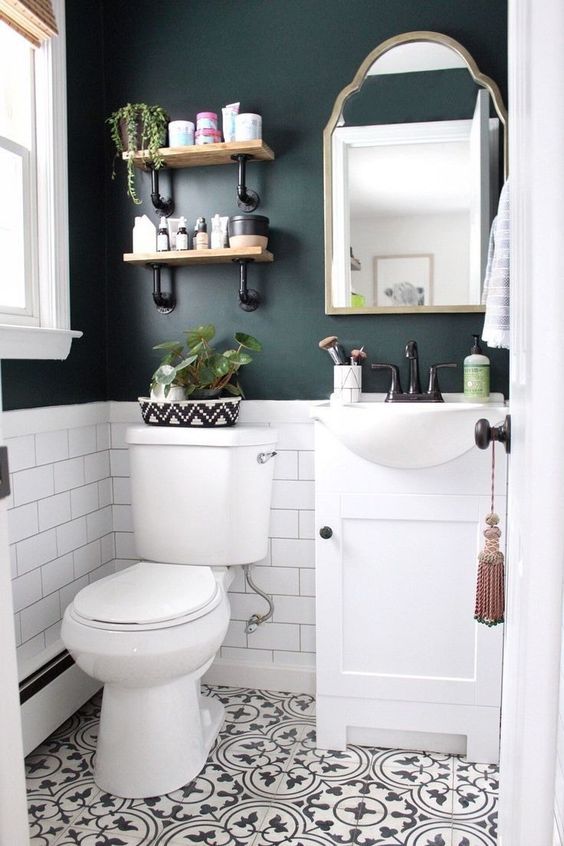
- In traditional bathroom designs featuring white sanitary fixtures, furniture is often chosen in soft pastel hues to maintain a light and airy overall ambiance. Alternatively, opting for bold and vibrant cabinet colors can add an eclectic touch and enliven the space.
- It’s also crucial to consider the bathroom’s existing color scheme. If the room already incorporates bright shades, selecting more subdued colors for the furniture is advisable to avoid creating an overly busy or cluttered appearance.
- In smaller bathrooms, limiting the color palette to no more than three shades is recommended to prevent visual overload and ensure the design concept remains clear and cohesive.
Current Styles Interior
This year’s interior design trend favors serene environments, eschewing bold colors and extravagant designs. Smooth lines and proper forms are highly sought after. Additionally, there’s a growing trend towards blending different styles. In bathrooms, the vintage look is increasingly giving way to contemporary technology. Among the popular styles, a few stand out.
Minimalism
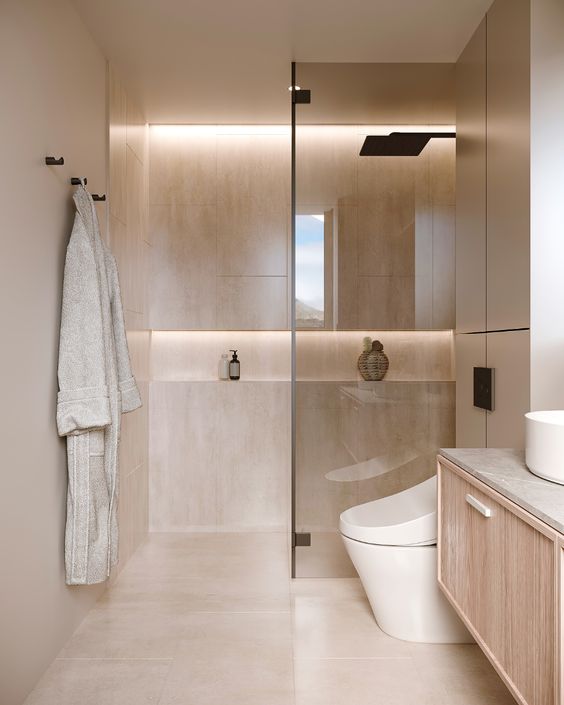
Minimalism is characterized by simple forms, clean lines, and minimal decorative elements. However, current trends spice minimalism with unique elements, like a statement mirror. In a minimalist bathroom, furniture tends to be sparse but typically enclosed. While open storage solutions for bath accessories might look appealing in photographs, they often lead to a cluttered appearance in real life as the number of items increases.
Loft Style
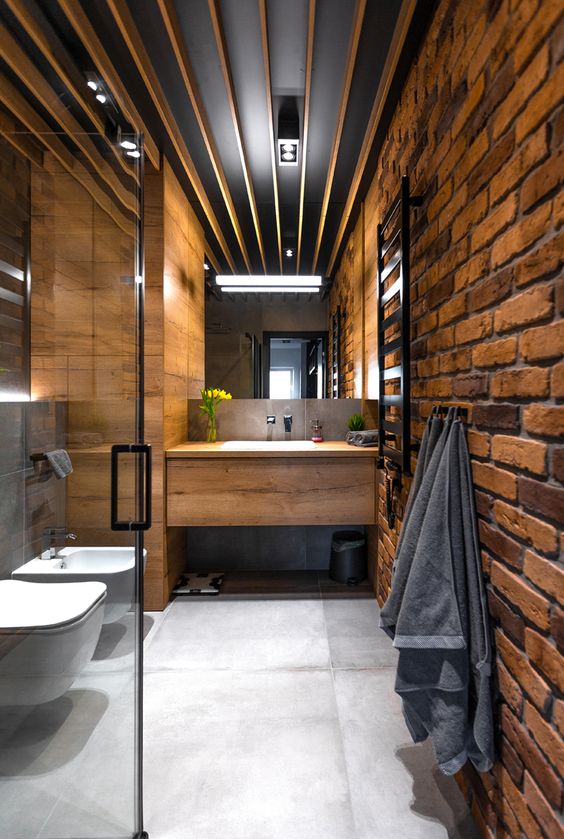
Despite experts frequently labeling the loft style as passé, it continues to win the hearts and wallets of people year after year. This stern industrial aesthetic leans towards raw materials like concrete, brick, and robust metal structures. In the 2024 trends, the loft style embraces large, seamless tiles that create a unified surface effect. It adeptly merges a penchant for natural hues and woods with high-tech bathroom fixtures, securing its place in the year’s trend list.
Contemporary Style
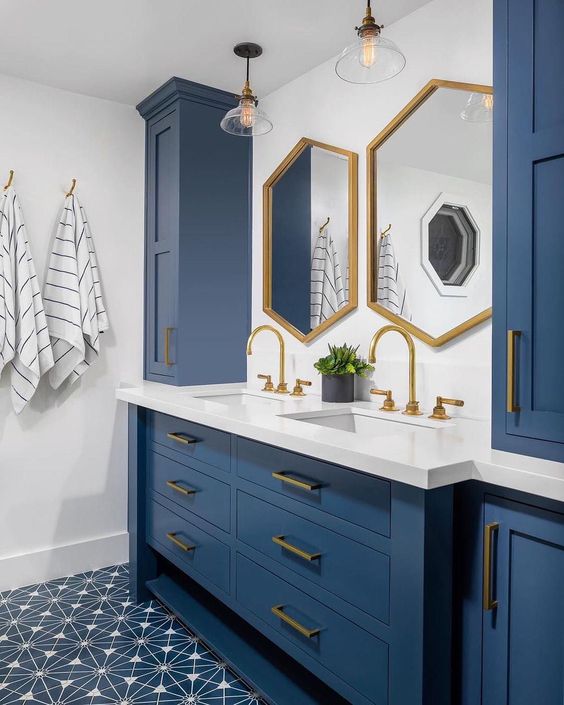
The contemporary bathroom style shares a close kinship with minimalism, featuring similar traits such as clean lines, right angles, and sleek furniture surfaces. Yet, it’s more adaptable, allowing for a broader range of decor elements in moderation. Unlike the pastel-dominated palette of minimalism, contemporary design harmonizes beautifully with bolder colors, like ruby or emerald tiles. Its hallmark lies in prioritizing maximum functionality and convenience, aligning with the current movement toward technologically advanced bathroom fixtures.
Scandinavian Style
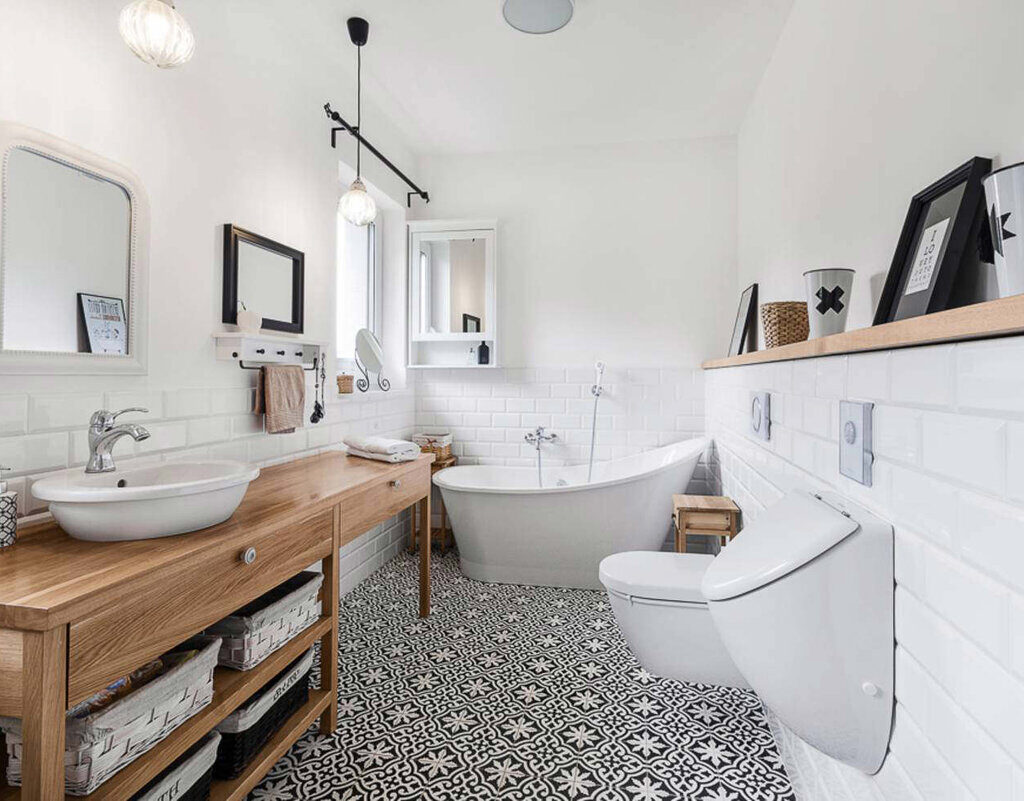
The essence of Scandinavian design in the bathroom is captured through its minimalism, refined elegance, and abundance of light. Harmonizing with this year’s trends, it employs a palette of soft, muted colors interspersed with a few vivid accents in natural hues and a preference for natural wood furniture. The Scandinavian style evokes a serene ambiance, ideal for unwinding in a leisurely bath, making it a haven of relaxation and comfort.
Style Fusion
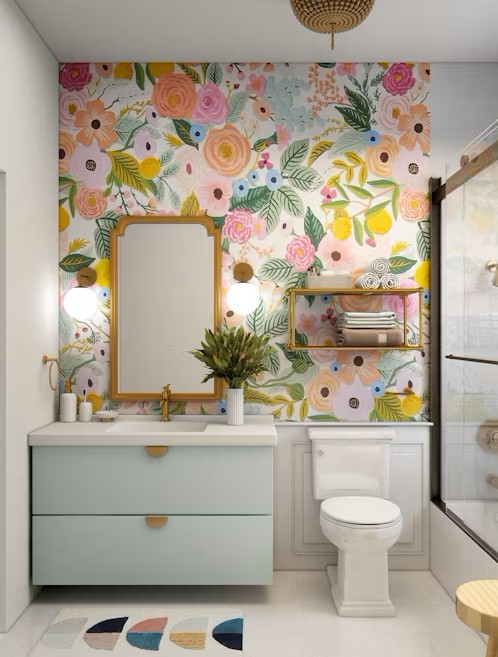
This year’s bathroom design trends see an intriguing fusion of different styles. It’s becoming common to spot a vibrant decorative piece in a minimalist bathroom or industrial loft elements in a contemporary setting. These eclectic combinations breathe new life into interiors, creating a distinctive, personalized space that resonates with individual preferences and aesthetics.
In conclusion, selecting the ideal bathroom cabinet is a task that marries functionality with style. To be complete, a bathroom requires cabinets that provide organized storage for essentials and gadgets and complement the room’s aesthetic. With the myriad of choices available, from various colors and materials to diverse styles and sizes, the key is to find a cabinet that enhances the efficiency and comfort of your bathroom space.
